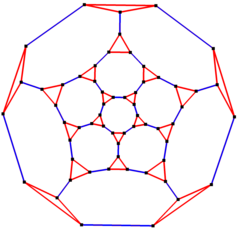Truncated dodecahedron
| Truncated dodecahedron | |
|---|---|
 | |
| Type | Archimedean solid |
| Faces | 32 |
| Edges | 90 |
| Symmetry group | icosahedral symmetry |
| Dihedral angle (degrees) | 10-10: 116.57° 3-10: 142.62° |
| Dual polyhedron | Triakis icosahedron |
| Vertex figure | |
 | |
| Net | |
 | |
In geometry, the truncated dodecahedron is an Archimedean solid. It has 12 regular decagonal faces, 20 regular triangular faces, 60 vertices and 90 edges.
Construction
[edit]The truncated dodecahedron is constructed from a regular dodecahedron by cutting all of its vertices off, a process known as truncation.[1] Alternatively, the truncated dodecahedron can be constructed by expansion: pushing away the edges of a regular dodecahedron, forming the pentagonal faces into decagonal faces, as well as the vertices into triangles.[2] Therefore, it has 32 faces, 90 edges, and 60 vertices.[3]
The truncated dodecahedron may also be constructed by using Cartesian coordinates. With an edge length centered at the origin, they are all even permutations of where is the golden ratio.[4]
Properties
[edit]The surface area and the volume of a truncated dodecahedron of edge length are:[3]
The dihedral angle of a truncated dodecahedron between two regular dodecahedral faces is 116.57°, and that between triangle-to-dodecahedron is 142.62°.[5]

The truncated dodecahedron is an Archimedean solid, meaning it is a highly symmetric and semi-regular polyhedron, and two or more different regular polygonal faces meet in a vertex.[6] It has the same symmetry as the regular icosahedron, the icosahedral symmetry.[7] The polygonal faces that meet for every vertex are one equilateral triangle and two regular decagon, and the vertex figure of a truncated dodecahedron is . The dual of a truncated dodecahedron is triakis icosahedron, a Catalan solid,[8] which shares the same symmetry as the truncated dodecahedron.[9]
The truncated dodecahedron is non-chiral, meaning it is congruent to its mirror image.[7]
Truncated dodecahedral graph
[edit]
In the mathematical field of graph theory, a truncated dodecahedral graph is the graph of vertices and edges of the truncated dodecahedron, one of the Archimedean solids. It has 60 vertices and 90 edges, and is a cubic Archimedean graph.[10]
Related polyhedron
[edit]The truncated dodecahedron can be applied in the polyhedron's construction known as the augmentation. Examples of polyhedrons are the Johnson solids, whose constructions are involved by attaching pentagonal cupolas onto the truncated dodecahedron: augmented truncated dodecahedron, parabiaugmented truncated dodecahedron, metabiaugmented truncated dodecahedron, and triaugmented truncated dodecahedron.[3]
See also
[edit]References
[edit]- ^ Ziya, Ümit (2019). "Truncated Truncated Dodecahedron and Truncated Truncated Icosahedron Spaces". Cumhuriyet Science Journal. 40 (2): 457–470. doi:10.17776/csj.534616.
- ^ Viana, Vera; Xavier, João Pedro; Aires, Ana Paula; Campos, Helena (2019). "Interactive Expansion of Achiral Polyhedra". In Cocchiarella, Luigi (ed.). ICGG 2018 - Proceedings of the 18th International Conference on Geometry and Graphics: 40th Anniversary - Milan, Italy, August 3-7, 2018. p. 1122. doi:10.1007/978-3-319-95588-9. ISBN 978-3-319-95588-9.
- ^ a b c Berman, Martin (1971). "Regular-faced convex polyhedra". Journal of the Franklin Institute. 291 (5): 329–352. doi:10.1016/0016-0032(71)90071-8. MR 0290245. See in particular page 336.
- ^ Weisstein, Eric W. "Icosahedral group". MathWorld.
- ^ Johnson, Norman W. (1966). "Convex polyhedra with regular faces". Canadian Journal of Mathematics. 18: 169–200. doi:10.4153/cjm-1966-021-8. MR 0185507. Zbl 0132.14603.
- ^ Diudea, M. V. (2018). Multi-shell Polyhedral Clusters. Springer. p. 39. doi:10.1007/978-3-319-64123-2. ISBN 978-3-319-64123-2.
- ^ a b Koca, M.; Koca, N. O. (2013). "Coxeter groups, quaternions, symmetries of polyhedra and 4D polytopes". Mathematical Physics: Proceedings of the 13th Regional Conference, Antalya, Turkey, 27–31 October 2010. World Scientific. p. 48.
- ^ Williams, Robert (1979). The Geometrical Foundation of Natural Structure: A Source Book of Design. Dover Publications, Inc. p. 88. ISBN 978-0-486-23729-9.
- ^ Holden, Alan (1991). Shapes, Space, and Symmetry. Dover Books on Mathematics. Courier Corporation. p. 52. ISBN 9780486268514.
- ^ Read, R. C.; Wilson, R. J. (1998). An Atlas of Graphs. Oxford University Press. p. 269.
Further reading
[edit]- Cromwell, P. (1997). Polyhedra. United Kingdom: Cambridge. pp. 79–86 Archimedean solids. ISBN 0-521-55432-2.
























